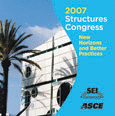International Distributed Hybrid Experiments on Bridge System
Publication: Structural Engineering Research Frontiers
Abstract
Experimental testing of structural systems is essential for improving knowledge about component and system performance in earthquakes. Shaking table testing can provide important experimental data about critical issues such as the effect of component damage on system response, collapse mechanisms, residual deformation and post-earthquake capacity. For example, the new E-Defense facility is a 20 m x 15 m six degree-of-freedom shaking table at the National Research Institute for Earth Science and Disaster Prevention (NIED) in Japan will provide significantly increased capability for structural experiments. Even with this facility, most structural systems are too large to test at or near full-scale. With recent improvement of the Internet all over the world, a geographically distributed testing allows researchers to combine the capabilities of two or more sites to conduct tests on structural systems that could not be performed at any one site because of capacity limits. In the United States, the George E. Brown, Jr. Network for Earthquake Engineering Simulation (NEES) is a network of experimental sites and computing resources connected by the NEESgrid system using Grid-based middleware. Under the NEES program, the Multi-site Online Simulation Test (MOST) demonstrated the use of NEESgrid for hybrid simulation, connecting two experimental sites and one or more computational sites. It showed the potential for distributed testing, but the software architecture included a coordinator that resulted in an artificial separation between the simulation model and the time integration procedure for solving the governing equations of motion. Even with these recent advances, structural testing has typically been conducted using customized software that is dependent on the configuration of an experiment and the computational procedure for the test method. Customized software, however, is difficult to adapt to other experiments, particularly when multiple sites need to communicate in a distributed test. For structural simulation, object-oriented methodologies were introduced in the beginning in 1990s. The first object-oriented analysis application was the linear and static finite element method. In 1990, Forde et al. defined classes such as Node, Material, and Element, for linear analysis. In the past decade, many researchers have developed object-oriented software for finite element analysis. In the paper, Using object-oriented software design methodologies, a framework of cooperating software classes is developed for a variety of experimental and computational approaches, allowing mixing of computational and experimental elements with communication between the two over a network.
Get full access to this article
View all available purchase options and get full access to this chapter.
Information & Authors
Information
Published In
Copyright
© 2007 American Society of Civil Engineers.
History
Published online: Jun 20, 2012
ASCE Technical Topics:
- Bridge components
- Bridge engineering
- Bridge tests
- Computer programming
- Computer software
- Computing in civil engineering
- Earthquakes
- Engineering fundamentals
- Field tests
- Finite element method
- Geohazards
- Geotechnical engineering
- Hybrid methods
- Linear analysis
- Methodology (by type)
- Numerical methods
- Structural analysis
- Structural engineering
- Structural systems
- Tests (by type)
Authors
Metrics & Citations
Metrics
Citations
Download citation
If you have the appropriate software installed, you can download article citation data to the citation manager of your choice. Simply select your manager software from the list below and click Download.
